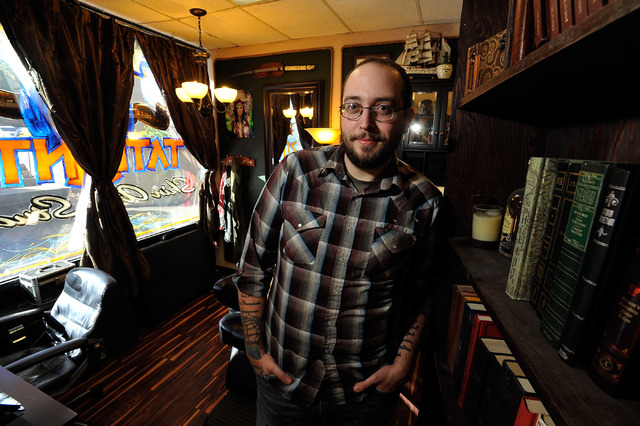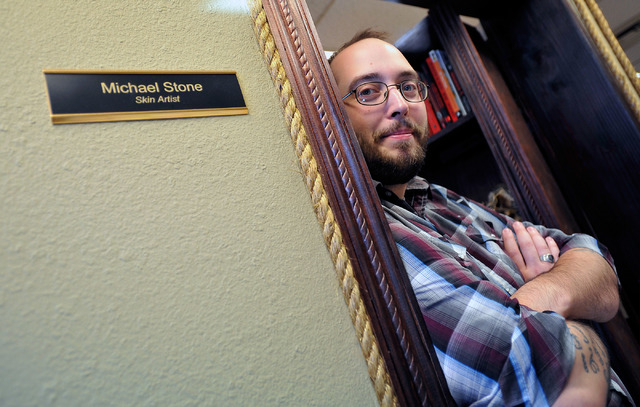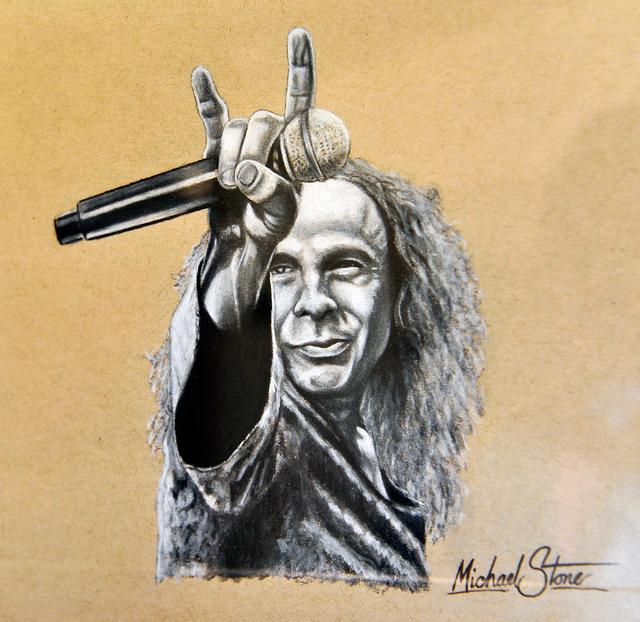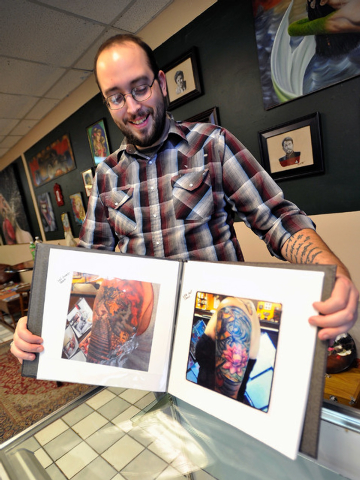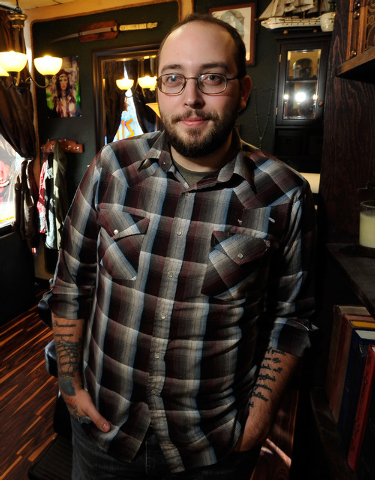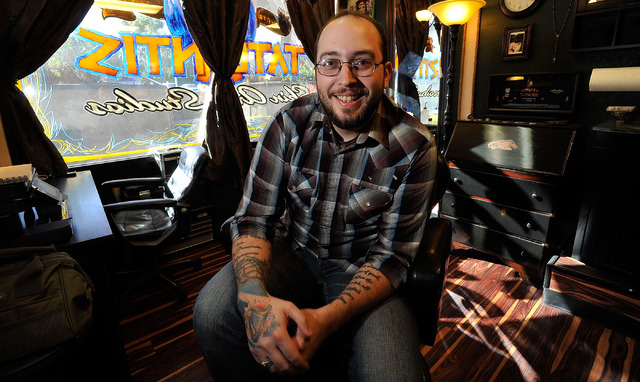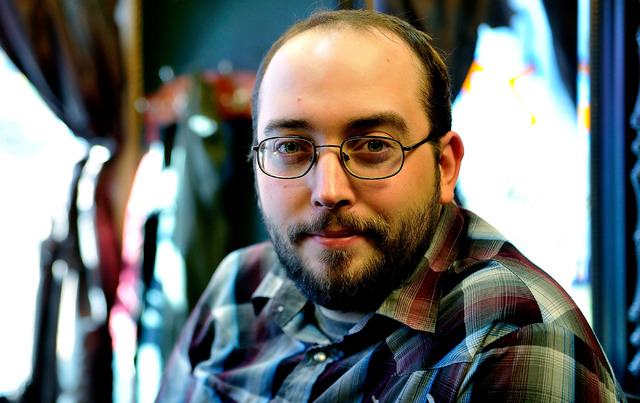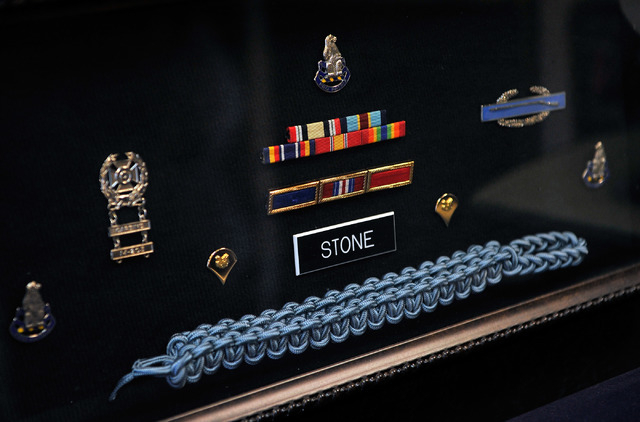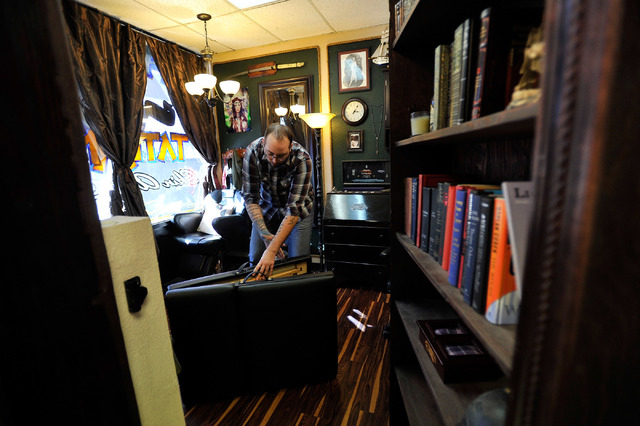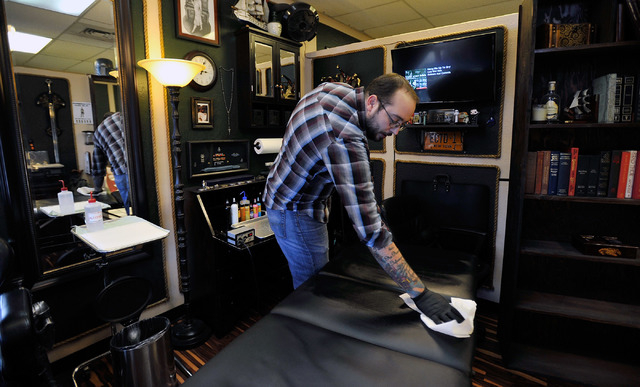Tattoo artists learn to make their mark
From hips and legs to arms and chests, tattoo artists leave their mark — quite literally — on customers, with designs ranging from iconic images and movie scenes to lyrics and names.
“If you made it out of the ’90s without getting a tribal tattoo, you were lucky,” says James Colceri, a local artist at Massive Tattoo Studio, admitting to the tribal tattoo on his back. “It’s in the process of being covered up.”
Though often hyped in television shows — “Ink Master” and “LA Ink” to name a couple — the industry isn’t as glamorous as people may think.
“People have this impression from reality TV shows that tattoo artists are rock stars,” Colceri says. “We are just regular people doing a job we love to do. It’s one of the best jobs.”
Michael Stone, who works at Tatlantis Allied Arts and Sciences, agrees.
“It is instant gratification as an artist,” Stone says. “You get paid for it right away and people give you kudos for it. Then, they walk out of here like walking billboards for everyone to see.”
To his surprise, Stone found tattooing is in his blood. Midway through his apprenticeship to become a tattoo artist, he met his father for the first time.
“He found me on MySpace,” Stone says.
They connected and to Stone’s surprise he discovered his father had also worked in the tattoo business for years.
“It was crazy to hear his stories about working with tattoo legends,” he adds.
Stone sits in his workstation, which is lined with oil paintings, memorabilia and even a mortar shell from a 155 round — his first blast he survived in Iraq.
The career seems to fit Stone, who has always been an artist working with various mediums.
But not seeing what he could do with it, Stone joined the Army.
He served in the infantry for almost four years, which included 15 months in Iraq.
During his tour, he survived five explosions.
“By the fifth one, I had a lot of nerve damage,” he says.
Though he couldn’t go out on patrols, he could still stay at base and man the radio.
During his time, he would draw — mostly pictures of women for his squad.
“I would get a lot of requests,” he adds. “They would always tell me I wouldn’t draw enough blondes.”
Stone was eventually medically discharged.
Not knowing what to do, he thought a good way to put his art to use would be to become a tattoo artist. He figured designing tattoos was the best way to make money as an artist.
He began apprenticing, which meant anything from mopping floors to performing odd jobs around the shop.
“It’s like being a private back in the Army,” he says. “You gotta pay your dues.”
When the person he apprenticed under felt he was ready, Stone began to work on people.
“The first time was nerve-racking,” he says. “I would almost rather do combat. I had to stop myself because I started to shake.”
But now, tattooing is almost second nature for him.
Looking for a change, Stone came to Las Vegas with a few thousand dollars to his name and the clothes on his back.
He started apprenticing at Tatlantis and has since developed a good clientele base.
Across town at Massive Tattoo Studio, Colceri sits at his workstation, also decorated with drawings and memorabilia.
He had always been into art since a young age.
“And I always liked tattoos,” he says. “I would always draw designs for friends.”
However, Colceri was forbidden from getting a tattoo before he was 18.
“My mom told me I better not get one before then,” he says. “And then a week before I turned 18, she got a tattoo just to piss me off. It was funny.”
Despite his love for tattoos, he went to college for fashion design.
“But I entered the industry 10 years too early,” Colceri says. “It was a very suit-and-tie type place. It’s not like it is now.”
By the time he entered the fashion industry, he had his fair share of ink covering parts of his body.
“It was hard to get a job,” he recalls.
Even when he did get a job, people would gawk at his designs.
He left fashion design and began looking for an apprenticeship in tattoo design.When he couldn’t find one in Seattle, he moved to Utah to work under his friend.
“I had a really good apprenticeship,” he says.
Along with grunt work such as cleaning the shop or setting up the workstation, Colceri also had assignments to help him as an artist.
“I was asked to draw 600 roses,” he says. “That was actually a homework assignment one night.”
The first tattoo he ever did was a skull on the inside of his calf.
“My first time on someone else wasn’t that scary,” he says. “I was only allowed to do simple stuff.”
After a while, Colceri says tattooing becomes muscle memory.
Regardless of where artists come from, once they come to Las Vegas they have to get certified by the Southern Nevada Health District to practice.
Robert Cole, the senior environmental specialist for the health district, inspects tattoo shops.
“We go around to shops twice a year,” he says. “They won’t have a grade like a restaurant. But they will have their health (status) permanently displayed.”
In Nevada, people aren’t allowed to practice in their kitchens.
“Other states allow it, but not in Nevada,” Cole says.
Those who aren’t certified are known as scratchers in the industry, “or as I like to call them, kitchen wizards,” Colceri says.
To be certified in Nevada, people must show their work history in the industry or an apprenticeship of at least six months.
Then, they have to pass a 100-question test that covers how to prevent the spread of blood-borne diseases, how often to change gloves, how to clean a tattoo once the design is finished and techniques of applying tattoos.
Getting certified isn’t the challenge, Colceri says. The scary thing about being an artist in Las Vegas is the amount of competition.
“There are a lot of shops and good artists,” he says.
But, Colcieri says, once you get a following, people spread the word about artists’ talents.
Though Stone and Colceri are at different shops, they agree requests for designs can be all over the place.
Stone says his weirdest request was a design of a kosher hamburger.
“She also wanted her name toasted on the (hamburger) bun,” he adds.
While in Utah, Colceri says an 18-year-old boy with no visible tattoos came in and requested Colceri tattoo the Joker’s makeup onto his face.
“I told him to get the (expletive) out of the shop,” he says.
Another weird request Colceri received was an entire arm of binary code, which is just ones and zeros.
“I turned it down,” he says. “I rarely say no, but that would have been too tedious.”
Most days, Colceri and Stone take on two or three clients; each can take as long as a three-hour session. Even if it is a larger piece, such as something that starts on the person’s hip but then wraps around his or her back, Stone says the session is usually broken up.
“You can only take the pain for so long,” he says.
They aren’t just putting designs on others. Both guys are covered in artwork.
“I lost count how many I have,” Stone says.
Colceri has even gotten more sensitive areas worked on, such as his armpits.
“I don’t think you can find a place on me that doesn’t have a tattoo on it,” he says.
For them, tattoos aren’t just random ink blots on their body parts. Each one tells a story about who they are.
“Tattoos are a collection,” Stone says. “It’s just like the shrapnel I have.”
Contact reporter Michael Lyle at mlyle@reviewjournal.com or 702-387-5201. Follow @mjlyle on Twitter.



